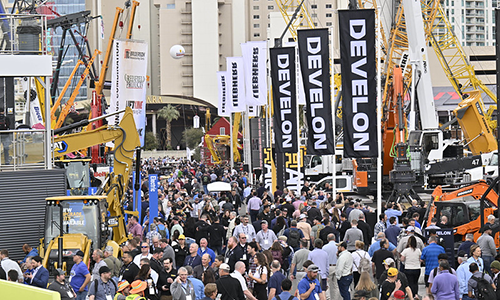Both the short-term and long-term futures of the equipment manufacturing industry are poised to be defined by a number of impactful trends in 2024 (and, in many cases, beyond).
It’s crucially important for the industry to understand these trends and how they are expected to evolve over time. Perhaps more importantly, however, equipment manufacturers must possess a strong idea of how these trends will impact their organizations and the customers they serve.
So, with that in mind, let’s take a look at four equipment manufacturing trends to watch in 2024:
1. Cybersecurity
By Sara Truesdale Mooney, AEM Senior Vice President, Membership, Business Development, & Data
When it comes to the current landscape of cybersecurity, experts agree it’s not a matter of if, but when, an organization will experience a cyberattack. With cybersecurity on the mind of everyone today (and for good reason), it goes without saying equipment manufacturers should be diligent about how they best defend against and prepare for attacks, as well as ensuring they have a proper incident response plan in place.
Gone are the days of single hackers operating on their own. Today, the vast majority of cybercrime is committed by global organizations with sophisticated business models that generate significant revenue and cause significant damage. By offering the necessary tools and stolen information for purchase online, these organizations also make it easy for anyone to launch ransomware attacks.
With all that in mind, it’s critically important for equipment manufacturers to ask themselves the following questions in order to determine if they could do more now to prepare for potential incidents in the future:
- Are we ready and properly prepared with an updated, practiced incident response plan?
- Have we properly vetted our vendors?
- Have we run tabletop exercises?
- If we are a victim of ransomware, are we going to pay or not?
Cybercrime is not something equipment manufacturers should take lightly. The financial and operational risk is far too great for organizations not to invest the necessary time, effort, and resources in protecting themselves and their data. However, by gaining a sound understanding of the current cybersecurity landscape, developing a reasoned and proper response plan, as well as learning how to most effectively defend against cyberattacks, equipment manufacturers can minimize risk, maximize security, and – perhaps most importantly – ensure they are well-positioned to continue to serve the needs and wants of their customers.
2. The Ever-Evolving Regulatory Environment
By Jason Malcore, AEM Senior Director of Safety & Product Leadership
Over the course of the 20th century, product regulations grew, expanded, and evolved to both reflect and respond to changing consumer behaviors and public opinion. The earliest product regulations generally focused on the immediate safety and health concerns of the user and other bystanders in the work environment. These rules included operator training and product performance requirements, electrical component certifications, and other worksite-related safety concerns. Over time, rules evolved to address the effects of the product beyond the worksite, including criteria pollutant and ozone depleting substance emissions, hazardous waste disposal, and noise emissions. Now, as we move into the future, the regulatory environment will focus on the long term, life cycle impacts of the product and the supply chains that support them.
Many of the regulatory issues we will see in 2024 and beyond will increasingly focus on these types of life-cycle regulations. The recent wave of global PFAS legislation, the battery passport requirements found in the European Union's Battery Regulation, the SEC’s Scope 3 emissions rule, and the EU’s Sustainable Products Initiative all require manufacturers to consider how their products are made, what substances are used in their construction, where they are manufactured, how they are disposed of, as well as a host of sustainability reporting requirements.
This emerging regulatory environment will require manufacturers to better understand their product portfolio’s value chains and to mitigate potential impacts on human health and the environment. Companies looking to successfully address these challenges will need to develop a comprehensive product compliance strategy, implement robust supply chain data collection processes, and engage with regulatory stakeholders to ensure policymakers understand the interests and need of manufacturers.
3. Changing Customer Expectations
By Sara Feuling, AEM Senior Director of Construction
The what, the how and the why of how customers buy equipment is changing. Some of the change is generational (as millennials now represent almost three-quarters of business-to-business (B2B) buyers), while some of the change is an extension of everyday life.
The evolution of technology is impacting lifestyle changes. Customers expect certain safety and comfort features in their personal vehicles, things like cameras, sensors, and heated seats; they are also now looking for those same features in the cab of a piece of equipment. Manufacturers will continue to explore how they can meet their customers' needs while balancing safety, efficiency, and cost.
That same technological evolution is also changing the way business is conducted. With the internet in the palms of their hands, customers have come to depend on the convenience of buying online; everything from clothes to groceries to equipment parts. The significance of the human side of doing business won’t be lost anytime soon, but a strong online presence and the ability to engage in meaningful ecommerce is becoming more and more important for manufacturers today.
As customers continue to consider and define their sustainability goals, manufacturers are beginning to better understand the equipment lifecycle. Sustainable equipment, not only its operation and maintenance, but also transparency through its supply chain and manufacturing, is becoming more of an expectation. That expectation will continue to change as the equipment manufacturing industry works to more effectively meet the evolving needs of its customers.
4. Agriculture’s Technological Transformation
By Austin Gellings, AEM Director of Agriculture
Agriculture is experiencing a seismic shift related to its underlying technologies, incorporating advancements from other industries while also leading the way in its own evolution.
Today, a combine cab is more like the cockpit of a spaceship than a combine cab from previous eras of agriculture. Additionally, ag is seeing a shift toward the use of different levels of automation and robotics, which is being enabled in large part by more interconnected, data driven systems. These data-driven systems are also leading to the incorporation of things like artificial intelligence and machine learning, so that equipment can help farmers make real-time decisions based off field conditions (as seen in targeted spray technologies).
While providing for more integration and connectivity, these systems are also leading to other new challenges and opportunities. One is actual connectivity to equipment, allowing for the transfer of data to the cloud and its use in offline decision-making by end users. Furthermore, the use of connected systems opens a whole new conversation related to the need for machine-level cybersecurity to both protect farmers’ data and equipment intellectual property.
These technological transformations, such as precision agriculture, enable farmers to adopt more sustainable farming practices and make direct decisions based off data from the equipment on a more granular level. The enables the farmer to enjoy a more efficient use of inputs and improve productivity.
Some of positive impacts include:
- Better soil health
- Improved water and air quality
- Reduced/more efficient use of inputs
- Increased outputs
- Improved biodiversity
- Reduced environmental footprint
- Increased labor efficiency
One ancillary outcome of such technological transformation and integration is the increased dialogue between the agriculture industry and several external stakeholders. This increased dialogue is leading to additional government and regulatory activity, as these groups look to better understand the role technology will play in shaping the future of sustainable food production.
For more perspectives from AEM staff, subscribe to the AEM Industry Advisor.





